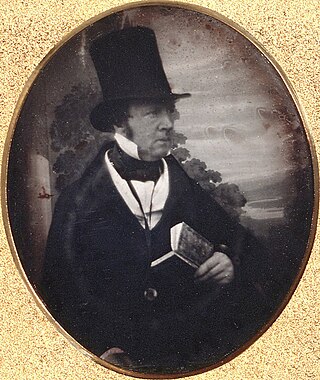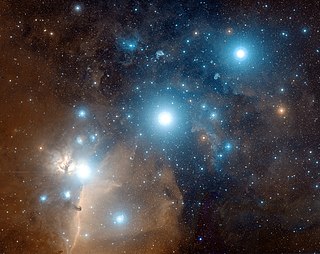
Photography is the art, application, and practice of creating images by recording light, either electronically by means of an image sensor, or chemically by means of a light-sensitive material such as photographic film. It is employed in many fields of science, manufacturing, and business, as well as its more direct uses for art, film and video production, recreational purposes, hobby, and mass communication. A person who makes photographs is called a photographer.

A photograph is an image created by light falling on a photosensitive surface, usually photographic film or an electronic image sensor, such as a CCD or a CMOS chip. Most photographs are now created using a smartphone or camera, which uses a lens to focus the scene's visible wavelengths of light into a reproduction of what the human eye would see. The process and practice of creating such images is called photography.

William Henry Fox Talbot FRS FRSE FRAS was an English scientist, inventor, and photography pioneer who invented the salted paper and calotype processes, precursors to photographic processes of the later 19th and 20th centuries. His work in the 1840s on photomechanical reproduction led to the creation of the photoglyphic engraving process, the precursor to photogravure. He was the holder of a controversial patent that affected the early development of commercial photography in Britain. He was also a noted photographer who contributed to the development of photography as an artistic medium. He published The Pencil of Nature (1844–1846), which was illustrated with original salted paper prints from his calotype negatives and made some important early photographs of Oxford, Paris, Reading, and York.

Daguerreotype was the first publicly available photographic process, widely used during the 1840s and 1850s. "Daguerreotype" also refers to an image created through this process.

Astrophotography, also known as astronomical imaging, is the photography or imaging of astronomical objects, celestial events, or areas of the night sky. The first photograph of an astronomical object was taken in 1840, but it was not until the late 19th century that advances in technology allowed for detailed stellar photography. Besides being able to record the details of extended objects such as the Moon, Sun, and planets, modern astrophotography has the ability to image objects outside of the visible spectrum of the human eye such as dim stars, nebulae, and galaxies. This is accomplished through long time exposure as both film and digital cameras can accumulate and sum photons over long periods of time or using specialized optical filters which limit the photons to a certain wavelength.

Johann Augustin Pucher was a Slovene priest, scientist, photographer, artist, and poet who invented an unusual process for making photographs on glass.

Louis-Jacques-Mandé Daguerre was a French artist and photographer, recognized for his invention of the eponymous daguerreotype process of photography. He became known as one of the fathers of photography. Though he is most famous for his contributions to photography, he was also an accomplished painter, scenic designer, and a developer of the diorama theatre.

A diorama is a replica of a scene, typically a three-dimensional model either full-sized or miniature. Sometimes it is enclosed in a glass showcase for a museum. Dioramas are often built by hobbyists as part of related hobbies such as military vehicle modeling, miniature figure modeling, or aircraft modeling.
Erotic photography is a style of art photography of an erotic, sexually suggestive or sexually provocative nature.

Heliography from helios, meaning "sun", and graphein (γράφειν), "writing") is the photographic process invented, and named thus, by Joseph Nicéphore Niépce around 1822, which he used to make the earliest known surviving photograph from nature, View from the Window at Le Gras, and the first realisation of photoresist as means to reproduce artworks through inventions of photolithography and photogravure.

The history of photography began with the discovery of two critical principles: The first is camera obscura image projection, the second is the discovery that some substances are visibly altered by exposure to light. There are no artifacts or descriptions that indicate any attempt to capture images with light sensitive materials prior to the 18th century.

Dr. Samuel A. Bemis (1793–1881) was one of the earliest photographers in the United States. A small number of his daguerreotypes have survived.

The history of the camera began even before the introduction of photography. Cameras evolved from the camera obscura through many generations of photographic technology – daguerreotypes, calotypes, dry plates, film – to the modern day with digital cameras and camera phones.

Robert Cornelius was an American photographer and pioneer in the history of photography. His daguerreotype self-portrait taken in 1839 is generally accepted as the first known photographic portrait of a person taken in the United States, and a very important achievement for self-portraiture. He operated some of the earliest photography studios in the United States between 1840 and 1842 and implemented innovative techniques to significantly reduce the exposure time required for portraits.

The Boulevard du Temple, formerly nicknamed the "Boulevard du Crime", is a thoroughfare in Paris that separates the 3rd arrondissement from the 11th. It runs from the Place de la République to the Place Pasdeloup, and its name refers to the nearby Knights Templars' Temple, where they established their Paris priory.

View from the Window at Le Gras is a heliographic image and the oldest surviving camera photograph. It was created by French inventor Nicéphore Niépce sometime between 1822 and 1827 in Saint-Loup-de-Varennes, France, and shows parts of the buildings and surrounding countryside of his estate, Le Gras, as seen from a high window.
The French firm Susse Frères manufactured a daguerreotype camera which was one of the first two photographic cameras ever sold to the public. The company was also engaged in the foundry business and owned a large foundry in Paris.

Noël Marie Paymal Lerebours was a French optician and daguerreotypist. He is best known today for his Excursions Daguerriennes, books of views of the world's monuments, based on early photographs redrawn by hand as Aquatint engravings.
The practice and appreciation of photographyin the United States began in the 19th century, when various advances in the development of photography took place and after daguerreotype photography was introduced in France in 1839. The earliest commercialization of photography was made in the country when Alexander Walcott and John Johnson opened the first commercial portrait gallery in 1840. In 1866, the first color photograph was taken. Only in the 1880s, would photography expand to a mass audience with the first easy-to-use, lightweight Kodak camera, issued by George Eastman and his company.

The Kynžvart Daguerreotype or Still Life with Jupiter Tonans is an early daguerreotype made in 1839 by Louis Daguerre. It was inscribed in the UNESCO Memory of the World Register in 2017, where it was described as a "highly important document of a new type of visual information carrier". It has also been a Czech national cultural monument, registration number 305, since 2006.

















